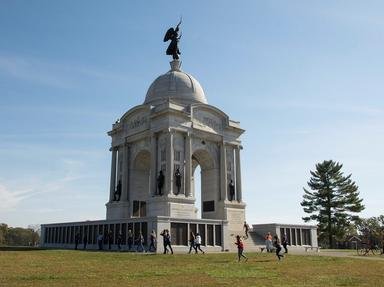Quiz Answer Key and Fun Facts
1. In the Union 1st corps commanded by Gen. John Reynolds, which one of these men was NOT a division commander under his command?
2. Which Union officer commanded the famed "Irish Brigade" during the Battle of Gettysburg?
3. Who served as Gen. George Meade's Chief of Staff during the Battle of Gettysburg?
4. Which Union officer ordered instant death for any soldier who failed to do his duty at the Battle of Gettysburg?
5. Before command of the Union Army of the Potomac was assigned to Gen. George Meade, which Union officer declined the command offer becuase he was not given free rein of the army and did not want to have to answer to politicians for his actions in the field?
6. Which officer, who was the son of a newspaper correspondent, was severely wounded in the leg and amputated the leg himself while continuing to command? He later died of his wound.
7. Which Union officer became separated from his men while retreating through the town of Gettysburg on July 1, 1863 and was forced to avoid being captured by the Confederates by hiding in a pig shed for the remainder of the battle?
8. On July 1, 1863, Gen. Francis Barlow occupied higher ground northeast of Gettysburg in an effort to hold off Confederate troops arriving from that direction. Barlow was very seriously wounded in the process and the area became known as "Barlow's Knoll" in his honor. What was the original name for this location.
9. Gen. John Newton, who replaced Gen. Abner Doubleday, (who replaced the deceased Gen. John Reynolds) as the commander of the Union 1st corps during the battle of Gettysburg, was selected to command the 1st corps because he was from nearby York, Pennsylvania and very familiar with Gettysburg before the battle.
10. Of the 14 officers that served as Union corps commanders during the battle of Gettysburg, how many were West Point Military Academy graduates?
11. Of the 14 officers that served as Union corps commanders during the battle of Gettysburg, how many of these commanders were natives of Confederate states?
12. The Union commanding general, Geroge Meade, was born in Pennsylvania.
13. During the Battle of Gettysburg, Andrew Curtin was the Governor of Pennsylvania. Which Union officer that fought at Gettysburg was elected to serve as governor of that state after Curtin?
14. Which Union cavalry commander was killed at the Battle of Gettysburg after the Confederate attack known as "Pickett's Charge" on July 3, 1863 was completed?
15. How many Union officers had tactical command of the Army of the Potomac on July 1, 1863?
Source: Author
Snorf1124
This quiz was reviewed by FunTrivia editor
bloomsby before going online.
Any errors found in FunTrivia content are routinely corrected through our feedback system.


